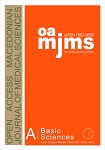Piper betle Leaf Extract Exhibits Anti-virulence Properties by Downregulating Rhamnolipid Gene Expression (rhlC) of Pseudomonas aeruginosa
DOI:
https://doi.org/10.3889/oamjms.2020.5247Keywords:
Piper betle, Pseudomonas aeruginosa, Rhamnolipid C, Rhamnolipid, BiofilmAbstract
BACKGROUND: Piper betle (P. betle) is widely used as a traditional medicine in Indonesia, with anti-quorum sensing and anti-biofilm activity. We investigated the impact of methanolic leaf extract of P. betle against Pseudomonas aeruginosa’s (P. aeruginosa) virulence factor, which associated with rhamnolipid (rhl) genes,
METHODS: Minimum biofilm inhibitory concentration of the extract was determined at a concentration of 0.4% by agar dilution assay. The expression of rhlA and rhlC gene was assessed by using real-time polymerase chain reaction.
RESULTS: All P. aeruginosa isolates contained rhlA, rhlB, and rhlC genes, which associated with rhl production. The expression of the rhlC gene decreased after administration of P. betle leaf extract at concentration of 0.4%, with beta coefficient was 0.662 (p = 0.019).
CONCLUSION: The methanolic leaf extract of P. betle shows inhibition of rhlC gene expression, indicating the anti-rhl properties of P. betle against P. aeruginosa infection.
Downloads
Metrics
Plum Analytics Artifact Widget Block
References
Macia MD, Rojo-Molinero E, Oliver A. Antimicrobial susceptibility testing in biofilm-growing bacteria. Clin Microbiol Infect. 2014;20(10):981-90. https://doi.org/10.1111/1469-0691.12651 PMid:24766583 DOI: https://doi.org/10.1111/1469-0691.12651
Vital-Lopez FG, Reifman J, Wallqvist A. Biofilm formation mechanisms of Pseudomonas aeruginosa predicted via genome-scale kinetic models of bacterial metabolism. PLoS Comput Biol 2015;11(10):e1004452. https://doi.org/10.1371/ journal.pcbi.1004452 PMid:26431398 DOI: https://doi.org/10.1371/journal.pcbi.1004452
Moradali MF, Ghods S, Rehm BH. Pseudomonas aeruginosa lifestyle: A paradigm for adaptation, survival, and persistence. Front Cell Infect Microbiol. 2017;7:39. https://doi.org/10.3389/ fcimb.2017.00039 PMid:28261568 DOI: https://doi.org/10.3389/fcimb.2017.00039
Rasamiravaka T, Labtani Q, Duez P, El Jaziri M. The formation of biofilms by Pseudomonas aeruginosa. Biomed Res Int. 2015;2015:759348. https://doi.org/10.5772/intechopen.90833 PMid:25866808 DOI: https://doi.org/10.1155/2015/759348
Chong H, Li Q. Microbial production of rhamnolipids: Opportunities, challenges and strategies. Microb Cell Fact. 2017;16:137. https://doi.org/10.1186/s12934-017-0753-2 DOI: https://doi.org/10.1186/s12934-017-0753-2
Teanpaisan R, Kawsud P, Pahumunto N, Puripattanavong J. Screening for antibacterial and antibiofilm activity in Thai medicinal plant extracts against oral microorganisms. J Tradit Complement Med. 2017;7(2):172-7. https://doi.org/10.1016/j. jtcme.2016.06.007 PMid:28417087 DOI: https://doi.org/10.1016/j.jtcme.2016.06.007
Datta S, Jana D, Raj T, Aveek M. Piper betle leaf extract affects the quorum sensing and hence virulence of Pseudomonas aeruginosa PAO1. Biotech. 2016;6(1):1-6. https://doi. org/10.1007/s13205-015-0348-8 PMid:28330090 DOI: https://doi.org/10.1007/s13205-015-0348-8
Aara A, Chappidi V, Ramadas MN. Antioxidant activity of eugenol in Piper betel leaf extract. J Fam Med Prim Care. 2020;9(1):327- 31. https://doi.org/10.4103/jfmpc.jfmpc_809_19 PMid:32110613 DOI: https://doi.org/10.4103/jfmpc.jfmpc_809_19
Miladi H, Zmantar T, Kouidhi B, Chaabouni Y, Mahdouani K, Bakhrouf A, et al. Use of carvacrol, thymol, and eugenol for biofilm eradication and resistance modifying susceptibility of Salmonella enterica serovar Typhimurium strains to nalidixic acid. Microb Pathog. 2017;104:56-63. https://doi.org/10.1016/j. micpath.2017.01.012 PMid:28062292 DOI: https://doi.org/10.1016/j.micpath.2017.01.012
Lou Z, Letsididi KS, Yu F, Pei Z, Wang H, Letsididi R. Inhibitive effect of eugenol and its nanoemulsion on quorum sensing-mediated virulence factors and biofilm formation by Pseudomonas aeruginosa. J Food Prot. 2019;82(3):379-89. https://doi.org/10.4315/0362-028x.jfp-18-196 PMid:30785306 DOI: https://doi.org/10.4315/0362-028X.JFP-18-196
Christensen GD, Bisno AL, Parisi JT, McLaughlin B, Hester MG, Luther RW. Nosocomial septicemia due to multiply antibiotic-resistant Staphylococcus epidermidis. Ann Intern Med. 1982;96(1):1-10. https://doi.org/10.7326/0003-4819-96-1-1 PMid:7053681 DOI: https://doi.org/10.7326/0003-4819-96-1-1
Ionescu R, Mereuta I, Pelinescu D, Csutak O, Tanase AM, Vassu T, et al. Screening and molecular analyses for biosurfactant production by Pseudomonas aeruginosa strains from oil polluted soil. Rom Biotechnol Lett. 2019;24(4):692-6. https://doi.org/10.25083/rbl/24.4/692.696 DOI: https://doi.org/10.25083/rbl/24.4/692.696
Al-Shabib NA, Husain FM, Ahmad I, Baig MH. Eugenol inhibits quorum sensing and biofilm of toxigenic MRSA strains isolated from food handlers employed in Saudi Arabia. Biotechnol Biotechnol Equip. 2017;31(2):387-96. https://doi.org/10.1080/1 3102818.2017.1281761 DOI: https://doi.org/10.1080/13102818.2017.1281761
Twigg MS, Tripathi L, Zompra A, Salek K, Irorere VU, Gutierrez T, et al. Identification and characterisation of short chain rhamnolipid production in a previously uninvestigated, non-pathogenic marine pseudomonad. Appl Microbiol Biotechnol. 2018;102(19):8537-49. https://doi.org/10.1007/ s00253-018-9202-3 PMid:29992435 DOI: https://doi.org/10.1007/s00253-018-9202-3
Ahmed SA, Rudden M, Smyth TJ, Dooley JS, Marchant R, Banat IM. Natural quorum sensing inhibitors effectively downregulate gene expression of Pseudomonas aeruginosa virulence factors. Appl Microbiol Biotechnol. 2019;103(8):3521- 35. https://doi.org/10.1007/s00253-019-09618-0 PMid:30852658 DOI: https://doi.org/10.1007/s00253-019-09618-0
Downloads
Published
How to Cite
License
Copyright (c) 2020 Irene Ratridewi, Shod Abdurrachman Dzulkarnain, Andreas Budi Wijaya, Wisnu Barlianto, Sanarto Santoso, Dewi Santosaningsih (Author)

This work is licensed under a Creative Commons Attribution-NonCommercial 4.0 International License.
http://creativecommons.org/licenses/by-nc/4.0








